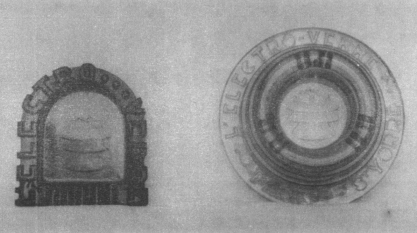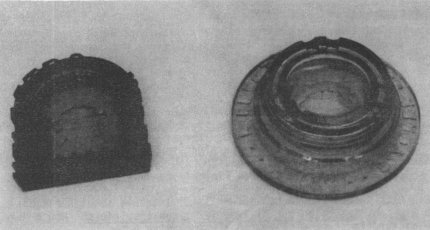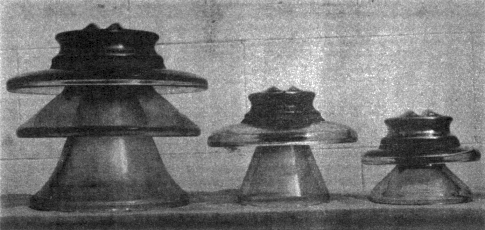Foreign Insulators
by Marilyn Albers
Reprinted from "INSULATORS - Crown Jewels of the Wire", December 1983, page 16
Hodge Podge Month
The Story
of a Company
Back in the January 1980 issue of Crown Jewels my column carried a
brief description of NZI (New Zealand Insulators Limited), a New Zealand based
manufacturer of porcelain insulators, which has two plants located in the
district of Canterbury, South Island, one in Temukah and the other in Ashburton.
We learned that NZI produces many types of insulators: high and low voltage pin
types, bobbins and reels, strain insulators, fuses, wiring accessories, etc.,
and that most of these insulators are glazed a lustrous chocolate brown. All
that was known to me at that time was that the eighty year old company had had a
small beginning, but with subsequent growth and an increase in technical
ability, NZI is today the leader of the technical ceramic industry in New
Zealand. I had no other details of the company's history.
Then a few weeks ago,
Gene Calman (San Diego, California) mailed me some additional information he'd
come across, and I learned that in 1971 a section of the Temuka plant, known as
Temuka Potteries, began making what is known as "Temuka Stoneware".
This is a lovely and durable type of oven to table ware and kitchen ware made
from vitrifying clay taken from Temuka Pottery's own quarry in South Canterbury.
Gene also supplied me with a company history, which I have found quite
interesting. It's always fun to find a missing part of the puzzle, and I'd like
to share this with you.
COMPANY HISTORY OF NEW ZEALAND INSULATORS LIMITED-TEMUKA
The land on which the factory now stands, together with much of the surrounding
land, was bought from the Government by Mr. Samuel Hewlings, a surveyor, in
1861. The land was described as swamp, covered with Ti-tree and flax.
There is
little to support the view that any business was set up on the land, although in
the book "A South Canterbury History", an incident is recalled of how
a Mr. George Leven "swam a horse over the fence of a brickyard owned by Mr.
Joseph Whitehead". Since this was in 1868, when the whole of Temuka was
flooded, it is difficult to establish where that brickyard was located.
Samuel
Hewlings began selling his land, and sections were sold in 1874, 1876 and 1878,
but again there is no evidence that businesses were set up on the land, much of
which changed hands frequently.
Archives of the local newspaper show that a Mr.
William Hoare acquired a piece of this land in 1894 to make bricks. It has been
suggested that these may have been sun-dried, but this cannot be substantiated.
On January 28, 1899, a sale notice appeared in the newspaper that on that day, a
"Brick-makers Business and Plant" in estate of the late William Hoare,
would be sold. Included in the sale was 1-3/4 acres of land, 2 kilns (type not
stated), pumps, etc. A significant statement was added, quote, "Good demand
for bricks in the district, and no other brickworks in the locality",
unquote. The business was believed to have been bought by Frederick Collier, a
Temuka Carrier.
On February 3, 1900, a further notice appeared in the
"Temuka Leader", stating that, quote, "Having secured a capital
section from Mr. James Davis, containing the best of clays and also the
necessary plant, I shall be prepared to supply bricks in any quantity at current
rates", unquote. He goes on to say that his first kiln would be ready in 4
to 6 weeks. This notice was signed W. Hoare, presumably the son of the late
William Hoare.
There are unsubstantiated reports that about this time, thoughts
were turning to the making of drain pipes from the clay to drain the surrounding
low lying areas. It is believed "Hoare & Page" undertook this
work.
In October 1903, there appeared a notice inserted by William Berry,
advising that having taken over the brickyard carried on by Hoare & Page of
Temuka, he hoped to supply bricks to the people in the district.
Competition
must have been fierce, because also in October 1903, Fred Collier inserted a
notice in the same newspaper, stating that, quote, "Having just built a new
and up-to-date kiln, and just burnt the first of season's bricks, I am prepared
to supply bricks in small or large quantities", unquote.
There is little
evidence of further activity, although land continued to be bought and sold,
until February 1916, when a number of sections were bought by the "Temuka
Pipe Works Company Ltd."
However, in April of the same year, the title was
transferred to the "Canterbury Pipe and Tile Co. Ltd." The name of
this company was changed to the Dominion Porcelain and Tile Industries Ltd., but
no date is shown on the document. The company began making insulators in 1918,
and a Mr. Brown and a Mr. Ballantyne are credited with making the first of
these.
In February 1924 the company was taken over by the National Electrical
& Engineering Co. Ltd. (NEECO), and became New Zealand Insulators Limited.
Little is known about the company's progress until World War II, when the output
of communication insulators soared, millions of these were destined for India.
In 1942, Mr. Tom Lovett took over the factory as Manager, and from this point,
the development in the manufacture of insulators really commenced after a move
by the New Zealand Government towards the supply of communication insulators to
British Standard Specifications. During this period the "Bottle Kiln"
was still the main firing medium and a total of nine were in operation. The
company, however, did operate an electric kiln in addition from 1943.
In March
1950, the main factory building burned down, and the cleared site made possible
a re-building program which permitted the move to oil fired tunnel kilns, the
first of which came into use in June 1954.
A further fire in 1959 destroyed the
electric kiln, and the decision was made not to reinstate it, but to hasten the
completion of the second oil-fired kiln then under construction. Both kilns were
130 ft. long, and extended to 150 ft. in 1975 and 1976. In 1964, the company saw
the introduction of several highly trained technical staff from the U.K. This
coincided with the building of a 14,000 sq. ft. factory at Tinwald, Ashburton,
for the production of metal parts and plastic components used in the assembly of
fuses, lamp holders, switches, connector blocks, etc. This was later extended.
Late in 1965, a new Toolroom and Drawing Office were built in Temuka.
The
company was bought by the Cable Price Downer Group in 1967, and New Zealand
Insulators became an independent subsidiary within this group.
Although a
limited range of domestic pottery was manufactured from 1920 onwards, these
included electric jugs, hot water bottles, bread crocks and vases, it was in
1971 that production of our distinctive domestic stoneware began. The company
now supplies a comprehensive range of tableware and ovenware for both the home
and overseas markets. So great has been the demand for these products, that a
new 10,000 sq. ft. extension was opened in March 1977, solely for the production
of Temuka Stoneware.
The name "Temuka" is shortened from Te-umu-kaha,
which means "The Fierce Oven". A place where local *Maoris dug large
pit-type ovens for communal cooking. Layers of leaves cover large heated stones
in these ovens -- with flax baskets of food being placed on top -- completely
covered with layers of flax and finally earth, until food was steam-cooked (few
hours) then opened. Whole pigs, vegetables, etc. were cooked in this method.
The
most important aspect of the company's business remains the servicing of the
Electrical Distribution Industry with its major commitment of resources being
towards the manufacture of insulators for service on distribution and
transmission lines from 440 volt up to 220 Kv.
Today the factory employs 400
people in its Temuka and Ashburton plants, and is not only an efficient New
Zealand industry, but is important to the national economy in that it makes
essential products largely from local raw materials, thus making and saving
substantial overseas funds.
*Indians
Insulator Ash Trays
I got a real thrill a while back
when UPS brought me a box from Tom Moulton (Ballston Lake, New York). "What
on earth," I thought, "I don't remember ordering anything from him
recently." What a good insulator day it was when I opened the box and
discovered two French glass ash trays. Each one was slightly different, but both
had an embossed triple skirted insulator (like C.D. 378) at the center. Standing
out in raised letters around the edges of each ash tray were the words L'Electro
Verre, and the larger of the two also had the words Paris and St. Yorre. The
color is a green aqua, exactly like the dozens of L'Electro Verre insulators I've
seen. (You do learn to recognize it after a while. The same is true of any
specialty collector.) Undoubtedly the ash trays had been made up at one time as
gifts for existing or prospective customers and had probably come from the same
batch of glass that had been used to make insulators.
You probably remember that
L'Electro Verre was the name of a small French glass manufacturer that merged
with the Insulator Department of the Charbonneaux Glass works at the beginning
of 1959 in order to form the new Sediver Company. Today, many years later, that
company has grown into a great sales organization, known as Sediver
International, which exports French insulators to just about every corner of the
earth. Their headquarters and main sales office is in Paris.
Insulators marked
L'Electro Verre date before that 1959 merger. The present day insulators
marketed by Sediver are embossed E.I.V., which stands for Societe Europeene D'
Isolataurs en Verre, or loosely: European Society of glass makers. These are
manufactured by the Saint Gobain Glassworks in St. Yorre, which is a Sediver
subsidiary, but also a major shareholder.
I have no facts to support it, but
because the largest ash tray has on it the names Paris and St. Yorre, I would
guess that perhaps L'Electro Verre at one time occupied the same plant as does
Saint Gobain Glassworks, and Paris was probably their sales office.
I'm very
proud to have these ash trays, and what a perfect "go-with" they are!
When the box first arrived, there was a note with them from Tom asking, "Do
you know of anyone who collects this sort of thing?" He'd found them at a
flea market, and he had to be smiling when he wrote this, knowing I would go
straight up. And I did. One more time, Tom, thanks for sending them!


"Copper tops" from Australia
In the picture following you see three
large glass power insulators with copper tops. These are from the collection of
Laura Van der Endt (Sidney, Australia).

11-3/4 x 10-1/2
(width) (height) |
9 x 7-1/2
(width) (height) |
7-1/8 x 5-1/2
(width) (height) |
Laura tells me these were found in only
one place in Australia, and she's understandably not saying where! There are no
markings on them at all, but after looking at an insulator catalogue put out by
Pilkington Brothers (St. Helens, England) and seeing the striking resemblance to
three of their styles, also with copper tops, Mr. N. R. Woodward (Houston,
Texas) suggested that they might be unmarked Pilkington insulators. That company
did certainly export insulators to all parts of the world.
I now have duplicates
of the two smaller insulators in my own collection, so we are able to examine
them first hand. The pale ice green tint of the glass is identical to a
suspension disc I have that is definitely a Pilkington specimen, because it is
marked with their trade name of "Armourlight" to identify it as
toughened glass.
In the photo, the largest insulator at the left has not yet
been assigned a C.D. number (or been identified as an already existing one), but
the medium size one (center) is now C.D. 344.2, and the smallest (right) is C.D.
343.2. When the copper tops are shined up, these are just beautiful! If and when
we ever establish the identity of the manufacturer of these insulators, we will
let you know. As a point of interest, Pilkington Brothers stopped production of
high voltage insulators in 1970 when they merged with Sediver International.
However, they do still have a plant in South Africa which continues to
manufacture the high voltage pin types. Small world!
|
